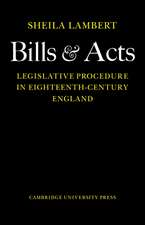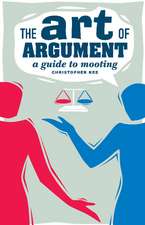Drafting Legislation: Art and Technology of Rules for Regulation
Autor Professor Helen Xanthakien Limba Engleză Hardback – 15 oct 2014
Preț: 573.21 lei
Preț vechi: 773.79 lei
-26% Nou
Puncte Express: 860
Preț estimativ în valută:
109.68€ • 114.29$ • 90.82£
109.68€ • 114.29$ • 90.82£
Carte tipărită la comandă
Livrare economică 03-17 aprilie
Preluare comenzi: 021 569.72.76
Specificații
ISBN-13: 9781849464284
ISBN-10: 1849464286
Pagini: 400
Ilustrații: illustrations
Dimensiuni: 156 x 234 x 15 mm
Greutate: 0.74 kg
Ediția:New.
Editura: Bloomsbury Publishing
Colecția Hart Publishing
Locul publicării:London, United Kingdom
ISBN-10: 1849464286
Pagini: 400
Ilustrații: illustrations
Dimensiuni: 156 x 234 x 15 mm
Greutate: 0.74 kg
Ediția:New.
Editura: Bloomsbury Publishing
Colecția Hart Publishing
Locul publicării:London, United Kingdom
Caracteristici
The book explores the reasons why drafting rules have come about, thus encouraging readers to understand what is pursued by each rule and how each rule applies.
Notă biografică
Helen Xanthaki is Professor of Law and Legislative Drafting and Director of Research Studies at the Institute of Advanced Legal Studies of the University of London, and the Academic Director of the Sir William Dale Centre for Legislative Studies there.
Cuprins
1. Legislation as a Means of Regulation: Effectivenessin Legislative Drafting Introduction The Nature of Rules for Regulation: Art or Technology? The Universality of Rules for Regulation Compilations of Rules for Regulation: Homogeneity versus Rigidity? Conclusions 2. Drafting Instructions What are Drafting Instructions? Purposes of Drafting Instructions .The Four Principles of Drafting Instructions What is the Content of Drafting Instructions? Quality of Legislative Instructions Style of Drafting Instructions Conclusions: a Checklist for Quality Drafting Instructions To Sum Up: Checklist for Legislative Instructions 3. The Legislative Plan: Designing a Legislative Solution Designing a Legislative Solution: What is it? The Advantages of Compiling a Legislative Plan The Elements of Analysis in the Legislative Plan Analysis of the Existing Law Analysis of the Necessity of Legislation as a Solutionto the Identified Social Need Analysis of Potential Danger Areas Analysis of the Policy Options and the Preferred Legislative Solution Analysis of the Projected Interpretation of the Legislation Initial Considerations of Structure: Thring's Five 'Golden Rules' Conclusions 4. Structure of a Bill The Theory: Lord Thring's Five Rules of Drafting Revisited More Doctrine: Bergeron's Rules The Practice: Thornton's Approach Structure in Brief: the Traditional Style Structure in Brief: Innovation Arrangements in Parts Headings Sections Marginal Notes Marginal References Table of Arrangements or Arrangement of Sections Real Innovation: the Layered Approach An Example of the Layered Approach in Action:The Succession to Crown Act 2013 (UK) 5. Clarity, Precision, Unambiguity and the Legislative Sentence The Basics Ambiguity and Vagueness Semantic Ambiguity Common Problems with Small Words: May, Shall, And/Or Unless-Except Scale Indicators Terms Conveying Ranges of Numbers, Days, Dates and Ages That and Which Serial Commas and Ambiguity Syntactic Ambiguity or Ambiguity at the Sentence Level The Placement Problem Modifiers of Nouns Punctuation: Thornton's Four Rules of Punctuation Gender-Neutral Drafting (gnd) 6. Plain Language What is Plain Language? Plain Language Aspect 1: Knowing your Audience Plain Language Aspect 2: Easy Communication Common Problems of Legislative Texts Best Practices for an Easy Communication: Plain Language Innovations The Debate: Concerns with Plain Language Concern 1: Plain Language Lowers the Standardsof Good Writing Concern 2: Intelligibility Concern 3: Plain Language Can only be Achieved if Certainty is Sacrificed Concern 4: Plain Language Leads to a Loss of Established Meanings of Words Settled over Centuries of Judicial Interpretation The Way Forward 7. Preliminary Provisions The Structure of an Act Preliminary Provisions: A Plain Language Approach The Introductory Text (Formerly Known as Long Title) Enacting Clause Start Date (Formerly Known as Commencement) Application Provisions Innovations for the Future 8. Principal Provisions: the National, EU and International Dimension Principal Provisions Substantive Provisions Administrative Agency Provisions The EU Dimension: National Implementing Measures The Choice of Form The Choice of Language, Syntax and Structure Summing up The International Dimension: Implementing International Agreements Innovation 9. Final Provisions Saving ProvisionsTransitional Provisions Repeals and Consequential Amendments Purpose Clause/Objectives Commencement/Duration Provisions or Start/End Date Short Title Schedules Schedule of Definitions Other Schedules 10. Comparative Legislative Drafting The Clichés Statutory Interpretation Rules of Interpretation and Construction in the Common Law: Ilbert's Rules Rules of Interpretation and Construction in the Civil Law World The End of the Cold War in (Statutory) Interpretation Stare Decisis Drafting Rules and Conventions Conclusions 11. Time in Legislation Prospective Provisions Legalising Provisions Retrospective Legislation Retroactive Provisions The Drafter and Legalising Provisions 12. Amending Provisions Initial Considerations Express and Implied Amendment Direct and Indirect Amendment Drafting Techniques for Direct Textual Amendments Indirect Amendments Amalgamating Indirect Referential Amendmentwith Direct Textual Amendment Consequential Amendments Implied Repeals 13. Penal Provisions Drafting Instructions: Initial Considerations The Legislative Plan The Parts of a Penal Provisions Rules of Construction General Rules and Innovation Expressing the Conduct Sanctions Special Circumstances Defences Special Considerations 14. Delegated Legislation What is Delegated Legislation? The Role of the Drafter in Delegated Legislation Use of Delegated Legislation Validity of Delegated Legislation Construction 15. Drafting for Consolidation v Drafting for Codification Codification Consolidation Codification versus Consolidation Diverse Models and the EU 16. Taxation Legislation Understanding Drafting Instructions: Initial Considerations for the Drafter Analysing the Proposal Designing the Law Initial Design Drafting Verification Use of Code 17. Extra-territorial Legislation The Theory of Extra-territoriality: Realism, Liberalism and Beyond Extra-territoriality in Practice Blocking Legislation Alternatives to Blocking Legislation The Rules on Extra-territorial Legislation 18. Statutory Interpretation and Legislative Drafting Current Techniques of Statutory Interpretation in the UKThe Drafters' Duty Presumptions Maxims Drafting and Statutory Interpretation 19. Quality of Legislation Post-Lisbon and the Role of Parliaments The EU's Regulatory Framework for Legislative Quality The Post-Lisbon Smart Regulation Initiative The UK Approach to Regulatory Quality Modern Parliaments and Legislative Quality 20. Legislative Education and Training Education and Training Training versus Mentoring on the Job Clinical Education and Training in Legislative Drafting National versus Universal Training for Drafters Conclusions
Recenzii
Drafting Legislation is a formidable work. It is detailed, it is comprehensive, and, although dense in content, is a worthwhile read for the information it presents. Prof. Xanthaki has made an outstanding contribution to advancing what she correctly labels as the art and science of drafting. It is indispensable work for those serious about drafting legislation.
This book is a new project that brings together a decade or more of teaching, research and practice to analyse the function, objectives and ideas of legislative drafting. . the book certainly deserves to go to further editions .. Scholarship and wisdom in this excellent book. Its breadth of learning and its depth of practical wisdom should ensure that it becomes a standard reference book for drafting students and drafting practitioners alike. It deserves a permanent place on drafters' bookshelves alongside their favourite dictionary, their thesaurus, their prized books on writing techniques, and their well-thumbed Thornton.
The book is published in an auspicious moment, with the Cabinet Office and the Office of Parliamentary Counsel currently running a Good Law initiative . In part, this book might be seen as an advertisement for such a course (in legislative drafting) and it will be for those who read it to see whether they wish to take up the challenge.
Professor Xanthaki is one of those all too rare legal academics who deign to consider some of the more practical aspects of the practice of law (.). Professor Xanthaki is to be commended for taking a now accepted precept of drafting with the intended audience in mind and applying it in a much more rigorous way (.). She has done a great service to the drafting community in bringing together an enormous body of literature on legislative drafting, providing a framework for analysing it and performing that analysis on the many practical aspects of the discipline. The book is a valuable resource and stimulus for critically thinking about how laws should be drafted. Can there be any higher calling in the legal world?
Helen Xanthaki's new book on Drafting Legislation is a big leap forward (.) The book is an excellent introduction to drafting legislation from a modern perspective, useful to English and non-English readers.
A new book on legislative drafting is to be welcomed. Following her sensitive editing of the fifth edition of Thronton, Porfessor Xanthakin here sets herself the task of applying Flyvberg's model of phronetic social science to the process of legislative drafting. . Professor Xanthaki .. . is to be congratulated on presenting the reader with an impressively wide range of both official and academic literature on drafting
Xanthaki presents in Drafting Legislation a uniquely wide analysis of legislative drafting, and keeps true to her goal not to merely present legislative techniques but to critically analyse them.
The theoretical and doctrinal approach of the volume of Helen Xanthaki is undoubtedly innovative. The approach can only bring benefits.
The book of Helen Xanthaki is in many ways impressive and a high quality contribution.
This book is a new project that brings together a decade or more of teaching, research and practice to analyse the function, objectives and ideas of legislative drafting. . the book certainly deserves to go to further editions .. Scholarship and wisdom in this excellent book. Its breadth of learning and its depth of practical wisdom should ensure that it becomes a standard reference book for drafting students and drafting practitioners alike. It deserves a permanent place on drafters' bookshelves alongside their favourite dictionary, their thesaurus, their prized books on writing techniques, and their well-thumbed Thornton.
The book is published in an auspicious moment, with the Cabinet Office and the Office of Parliamentary Counsel currently running a Good Law initiative . In part, this book might be seen as an advertisement for such a course (in legislative drafting) and it will be for those who read it to see whether they wish to take up the challenge.
Professor Xanthaki is one of those all too rare legal academics who deign to consider some of the more practical aspects of the practice of law (.). Professor Xanthaki is to be commended for taking a now accepted precept of drafting with the intended audience in mind and applying it in a much more rigorous way (.). She has done a great service to the drafting community in bringing together an enormous body of literature on legislative drafting, providing a framework for analysing it and performing that analysis on the many practical aspects of the discipline. The book is a valuable resource and stimulus for critically thinking about how laws should be drafted. Can there be any higher calling in the legal world?
Helen Xanthaki's new book on Drafting Legislation is a big leap forward (.) The book is an excellent introduction to drafting legislation from a modern perspective, useful to English and non-English readers.
A new book on legislative drafting is to be welcomed. Following her sensitive editing of the fifth edition of Thronton, Porfessor Xanthakin here sets herself the task of applying Flyvberg's model of phronetic social science to the process of legislative drafting. . Professor Xanthaki .. . is to be congratulated on presenting the reader with an impressively wide range of both official and academic literature on drafting
Xanthaki presents in Drafting Legislation a uniquely wide analysis of legislative drafting, and keeps true to her goal not to merely present legislative techniques but to critically analyse them.
The theoretical and doctrinal approach of the volume of Helen Xanthaki is undoubtedly innovative. The approach can only bring benefits.
The book of Helen Xanthaki is in many ways impressive and a high quality contribution.
Descriere
This book constitutes the first thorough academic analysis of legislative drafting. It explores the reasons why drafting rules have come about and thus encourages readers to understand what is pursued by each rule and how each rule applies.











